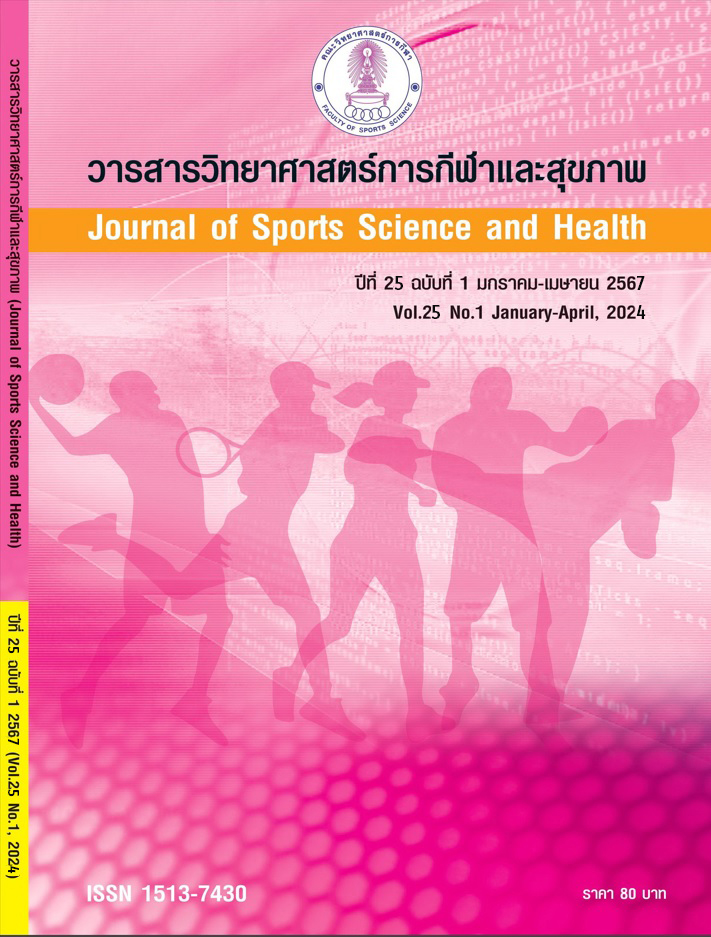EFFECTS OF ACTIVE RECOVERY COMBINED WITH SPORT MASSAGE ON LACTATE REMOVAL AND SWIMMING PERFORMANCE IN THAI NATIONAL SWIMMER
Main Article Content
Abstract
Purpose
To investigate the effects of active recovery combined with sport massage on lactate removal and swimming performance in Thai national swimmer.
Methods
Fifteen male Thai national swimmer, aged range between 18-24 years, were recruited. All of participants were in to 3 of tests (Active recovery, Sport massage recovery and Active recovery combine with sport massage) tasks separated by 1 week. The measurements of general physical characteristics, heart rate blood lactate concentration, stoke rate in a minute and performance time of 100 m. front crawl. The variables were analyzed using Paired-simple t-test and One-way ANOVA measure by Bonferroni. A significance level of 0.05 was considered the statistical significance.
Results
The mean values of blood lactate concentration and swimming performance in Active recovery combine with sport massage was higher than Active recovery and Sport massage recovery (p<.05).
Conclusion
The Active recovery combine with sport massage treatment had positive effects on lactate removal and swimming performance in swimmer after exercise and competition.
Article Details

This work is licensed under a Creative Commons Attribution-NonCommercial-NoDerivatives 4.0 International License.
References
Duffield, R., Dawson, B., Goodman, C. (2005). Energy system contribution to 400-metre and 800-metre track running. Journal of Sports Sciences, 23(3), 299-307.
Gladden, L.B. (2000). Muscle as a consumer of lactate. Medicine and science in sports and exercise, 32(4), 764-771.
Goats, G., & Keir, K. (1991). Connective tissue massage. British Journal of Sports Medicine, 25(3), 131-133.
Greenwood, J.D., Moses, G.E., Bernardino, F.M., Gaesser, G.A., & Weltman, A. (2008). Intensity of exercise recovery, blood lactate disappearance, and subsequent swimming performance. Journal of Sports Sciences, 26(1), 29-34.
Larson, L.M., Smeltzer, R.M., Petrella, J.K., & Jung, A.P. (2013). The effect of active vs. supine recovery on heart rate, power out, and recovery time. International Journal of Exercise Science, 6(3), 180-87.
McGillicuddy, M. (2011). Massage for sport performance. Illinois: Human Kinetics
Neric, F.B., Beam, W.C., Brown, L.E., & Wiersma, L.D. (2009). Comparison of swim recovery and muscle stimulation on lactate removal after sprint swimming. The Journal of Strength & Conditioning Research, 23(9), 2560-2567.
Ostojic, S.M., Markovic, G., Calleja-Gonzalez, J., Jakovljevic, D.G., Vucetic, V., & Stojanovic, M.D. (2010). Ultra short-term heart rate recovery after maximal exercise in continuous versus intermittent endurance athletes. European journal of applied physiology, 108(5), 1055–1059.
Piakaew, N., Suwannate, C., & Awilai, N. (2023). The Acute Effects of Swedish and Ice Massages on Muscle Relaxation after Training in Futsal Athletes. Journal of Sports Science and Health. 24(3), 28-41.
Plowman, S.A., and Smith, D.L. (1997). Exercise physiology for health, fitness, and performance. Boston, MA: Allyn and Bacon.
Rasooli, S.A., Jahromi, M.K., Asadmanesh, A., & Salesi, M. (2012). Influence of massage, active and passive recovery on swimming performance and blood lactate. The Journal of sports medicine and physical fitness, 52(2), 122–127.
Suwannimit, P. and Yoomuang, K., Srijaroonputong, S., Wongwilatnurak, S. & Kitsuksan, T. (2018). Effects of active recovery on physical performance and heart rate in healthy male aged 18-25 years. Thammasat Medical Journal. 18(3). 330-338.
Toubekis, A.G., Tsolaki, A., Smilios, I., Douda, H.T., Kourtesis, T., & Tokmakidis, S.P. (2008). Swimming performance after passive and active recovery of various durations. International journal of sports physiology and performance, 3(3), 375-386.
Vaile, J., Halson, S., & Graham, S. (2010). Recovery review: science vs. practice. The Journal of Australian Strength and Conditioning (JASC), 18(Suppl 2), 5-21.
Weerapong, P., Hume, P.A., & Kolt, G.S. (2005). The mechanisms of massage and effects on performance, muscle recovery and injury prevention. Sports medicine, 35(3), 235-256.


